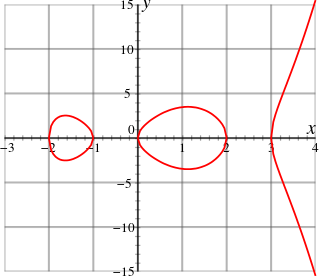
In mathematics, a Diophantine equation is an equation, typically a polynomial equation in two or more unknowns with integer coefficients, for which only integer solutions are of interest. A linear Diophantine equation equates to a constant the sum of two or more monomials, each of degree one. An exponential Diophantine equation is one in which unknowns can appear in exponents.

Faltings's theorem is a result in arithmetic geometry, according to which a curve of genus greater than 1 over the field of rational numbers has only finitely many rational points. This was conjectured in 1922 by Louis Mordell, and known as the Mordell conjecture until its 1983 proof by Gerd Faltings. The conjecture was later generalized by replacing by any number field.

In mathematics, particularly in algebraic geometry, complex analysis and algebraic number theory, an abelian variety is a projective algebraic variety that is also an algebraic group, i.e., has a group law that can be defined by regular functions. Abelian varieties are at the same time among the most studied objects in algebraic geometry and indispensable tools for research on other topics in algebraic geometry and number theory.

Geometry of numbers is the part of number theory which uses geometry for the study of algebraic numbers. Typically, a ring of algebraic integers is viewed as a lattice in and the study of these lattices provides fundamental information on algebraic numbers. Hermann Minkowski initiated this line of research at the age of 26 in his work The Geometry of Numbers.
In mathematics, a global field is one of two types of fields that are characterized using valuations. There are two kinds of global fields:
In mathematics, Diophantine geometry is the study of Diophantine equations by means of powerful methods in algebraic geometry. By the 20th century it became clear for some mathematicians that methods of algebraic geometry are ideal tools to study these equations. Diophantine geometry is part of the broader field of arithmetic geometry.
In mathematics, Roth's theorem or Thue–Siegel–Roth theorem is a fundamental result in diophantine approximation to algebraic numbers. It is of a qualitative type, stating that algebraic numbers cannot have many rational approximations that are 'very good'. Over half a century, the meaning of very good here was refined by a number of mathematicians, starting with Joseph Liouville in 1844 and continuing with work of Axel Thue, Carl Ludwig Siegel, Freeman Dyson, and Klaus Roth.

In mathematics, arithmetic geometry is roughly the application of techniques from algebraic geometry to problems in number theory. Arithmetic geometry is centered around Diophantine geometry, the study of rational points of algebraic varieties.
In number theory and algebraic geometry, a rational point of an algebraic variety is a point whose coordinates belong to a given field. If the field is not mentioned, the field of rational numbers is generally understood. If the field is the field of real numbers, a rational point is more commonly called a real point.
This is a glossary of arithmetic and diophantine geometry in mathematics, areas growing out of the traditional study of Diophantine equations to encompass large parts of number theory and algebraic geometry. Much of the theory is in the form of proposed conjectures, which can be related at various levels of generality.
In arithmetic geometry, the Bombieri–Lang conjecture is an unsolved problem conjectured by Enrico Bombieri and Serge Lang about the Zariski density of the set of rational points of an algebraic variety of general type.
In mathematics, Siegel's theorem on integral points states that for a smooth algebraic curve C of genus g defined over a number field K, presented in affine space in a given coordinate system, there are only finitely many points on C with coordinates in the ring of integers O of K, provided g > 0.
In mathematics, the subspace theorem says that points of small height in projective space lie in a finite number of hyperplanes. It is a result obtained by Wolfgang M. Schmidt.
In number theory, the Néron–Tate height is a quadratic form on the Mordell–Weil group of rational points of an abelian variety defined over a global field. It is named after André Néron and John Tate.
In mathematics, Arakelov theory is an approach to Diophantine geometry, named for Suren Arakelov. It is used to study Diophantine equations in higher dimensions.
In number theory, Szpiro's conjecture relates to the conductor and the discriminant of an elliptic curve. In a slightly modified form, it is equivalent to the well-known abc conjecture. It is named for Lucien Szpiro, who formulated it in the 1980s. Szpiro's conjecture and its equivalent forms have been described as "the most important unsolved problem in Diophantine analysis" by Dorian Goldfeld, in part to its large number of consequences in number theory including Roth's theorem, the Mordell conjecture, the Fermat–Catalan conjecture, and Brocard's problem.
In mathematics, the Bogomolov conjecture is a conjecture, named after Fedor Bogomolov, in arithmetic geometry about algebraic curves that generalizes the Manin-Mumford conjecture in arithmetic geometry. The conjecture was proven by Emmanuel Ullmo and Shou-Wu Zhang in 1998 using Arakelov theory. A further generalization to general abelian varieties was also proved by Zhang in 1998.
In mathematics, an arithmetic surface over a Dedekind domain R with fraction field is a geometric object having one conventional dimension, and one other dimension provided by the infinitude of the primes. When R is the ring of integers Z, this intuition depends on the prime ideal spectrum Spec(Z) being seen as analogous to a line. Arithmetic surfaces arise naturally in diophantine geometry, when an algebraic curve defined over K is thought of as having reductions over the fields R/P, where P is a prime ideal of R, for almost all P; and are helpful in specifying what should happen about the process of reducing to R/P when the most naive way fails to make sense.
In mathematics, Vojta's conjecture is a conjecture introduced by Paul Vojta about heights of points on algebraic varieties over number fields. The conjecture was motivated by an analogy between diophantine approximation and Nevanlinna theory in complex analysis. It implies many other conjectures in Diophantine approximation, Diophantine equations, arithmetic geometry, and mathematical logic.
In mathematics, the height zeta function of an algebraic variety or more generally a subset of a variety encodes the distribution of points of given height.




















